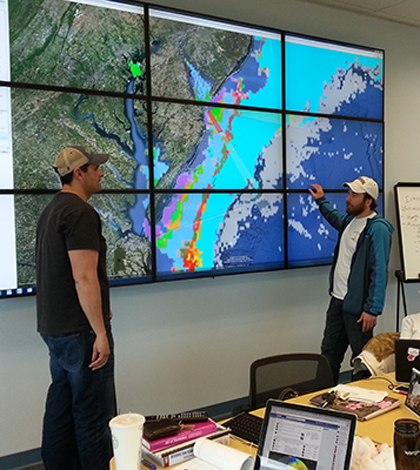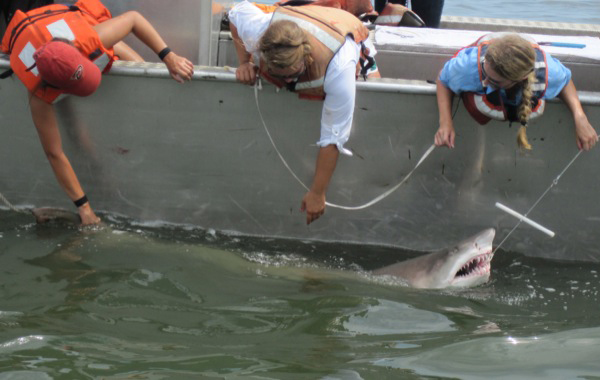Fisheries forecast could cut bycatch, keeping sharks and sturgeon out of commercial nets

Developing a fisheries forecast could help commercial fisherman avoid sharks and sturgeon in their nets (Credit: University of Delaware)
Fishing is important work, and commercial fishermen know that well. When they’re out on the water casting nets, they hope for big schools of fish that people eat – like tuna, perch or fluke. But sometimes they pull in protected species of fish, which gets them in trouble with authorities. This accidental catch is termed “bycatch,” and it can result in hefty fines for commercial fishermen. Not only that, but it dwindles already-low numbers of protected species like Atlantic sturgeon or sand tiger sharks.
To help mitigate the damage commercial bycatch causes to fishermen and fish alike, researchers at the University of Delaware and Delaware State University are developing a forecast tool that may one day be able to tell the locations of sturgeon and sand tiger sharks along the Atlantic Coast. The work will depend on satellite imagery of ocean color and sea-surface temperatures collected by the MODIS instrument on NASA’s Aqua satellite. From there, scientists will work to translate the information into something fishermen can use.
“One of the main things we’re looking for is habitat,” said Matt Oliver, associate professor of oceanography at the University of Delaware. He joins Delaware State’s Dewayne Fox in the effort. “We know in the ocean that there are certain temperatures that fish like and that colors are indicative of organic matter and productivity in a region.”
So by looking at those data, as well as those on upwelling, ocean plumes, turbidity and photons that the ocean reflects, a view of water structure begins to emerge. That can be cross-referenced with tracking data from networks of acoustic receivers along the Atlantic seaboard that monitor the movement of sharks and sturgeon.
Data from wildlife officials, the Atlantic Cooperative Telemetry Network that Fox has helped build, and the Mid-Atlantic Regional Association Coastal Ocean Observing System will be considered in the tool-building effort.

university of Delaware researchers tagging a sand shark for telemetry tracking efforts. (Credit: Matthew Breece)
“The best way to think about what we’re trying to do is a forecast that will give you a sense of where you’d interact with these species,” said Oliver. It would act as a risk analysis for fishermen, he says, just like a weather forecast helps people avoid getting caught in severe thunderstorms. “We’re trying to give fisherpeople as much information as we can and reduce the risk for them interacting with these species.”
If successful, Oliver says the approach could be applied to other fish species in other parts of the world. There’s no reason the work can’t be expanded, but putting together such tools requires a lot of in-situ biotelemetry data.
But the real question, says Oliver: Will fishermen use it?
“That’s a larger issue that includes social factors,” he said. “For example, you can have a fantastic forecast from the National Weather Service, but if people ignore it, so what?”
Top image: Developing a fisheries forecast could help commercial fisherman avoid sharks and sturgeon in their nets (Credit: University of Delaware)





0 comments